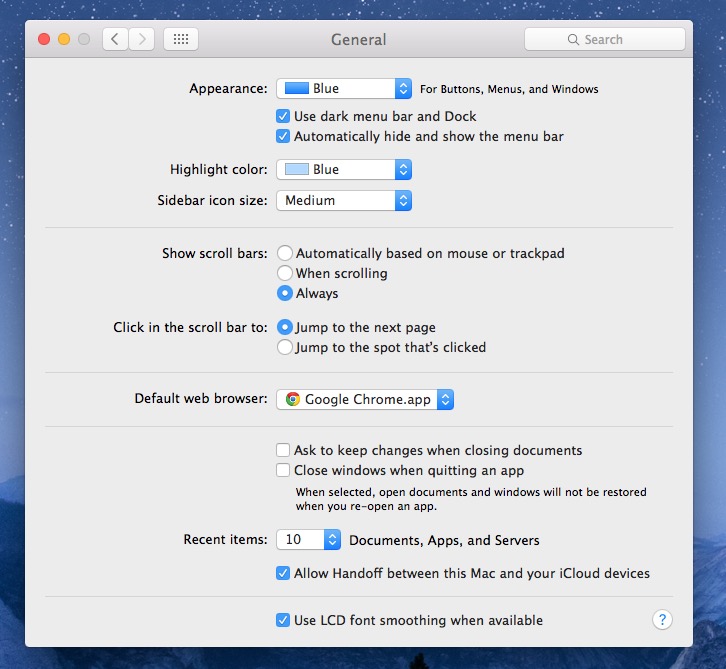How to Hide & Show the Menu Bar in Mac OS X

New versions of Mac OS allow Mac users to hide and show the menu bar at the top of the screen automatically, much like the Dock can be hidden and shown with a mouse over.
Auto-hiding the menu bar is a nice feature for Mac users who are fans of minimalist desktop appearances, as it really eliminates just about everything visible on the screen aside from whatever the applications and windows are actively open on the display.
How to Automatically Hide & Show the Menu Bar in Mac OS X
In modern macOS versions (Big Sur, Monterey, and newer):
- Open System Preferences from the Apple menu or with Spotlight
- Go to the “Dock & Menu Bar” preference panel”
- Check the box for “Automatically hide and show the menu bar” to hide the menu bar on Mac
For Mac OS X 10.11 to macOS Catalina:
- Open System Preferences from the Apple menu or with Spotlight
- Go to the “General” preference panel”
- Check the box for “Automatically hide and show the menu bar” to have the effect instantly take effect

When the menu bar is hidden, a quick mouse hover to the top of the display will reveal the menu bar, just like the same action makes the Mac Dock appear if it’s hidden too (which is also a great tip).
You can see the menu bar hiding and showing automatically in the animated gif below:

The video below demonstrates enabling the feature, and using the feature:
Personally I like the menu bar being visible all the time, primarily for ease of access but also to see the clock, battery, and wi-fi status icons. Nonetheless, many users will enjoy hiding the menu bar as it really does eliminate distractions, and it’ll free up a few more pixels at the top of any Mac display if you’re feeling particularly cramped with space.
You can obviously change this back to the default setting at any time by returning to the preference panel and unchecking the box for “Automatically hide and show the menu bar” again. If you’re looking for the menu bar to just be less distracting, another option is to switch it to dark mode which will display as black rather than white.
Making the Menu Bar in Mac OS X Visible or Invisible with defaults Command
Finally, for more advanced users who wish to use a defaults command string at the terminal, you can hide and show the menu bar with the following:
Enable automatically hide the menu bar in Mac OS X defaults command
:
defaults write NSGlobalDomain _HIHideMenuBar -bool true
Disable automatically hiding menu bar in Mac OS X defaults command
:
defaults write NSGlobalDomain _HIHideMenuBar -bool false
The false state is the default, meaning the menu bar is always visible and does not hide.
You may need to log out and back in or kill SystemUIServer for the change to take effect in some cases.
By the way, if you’re not on El Capitan 10.11 or newer, you can still hide and show the menu bar with this trick, which works all the way back to Snow Leopard, but requires the usage of a third party tool.
Do you hide or show the menu bar on your Mac? Let us know your thoughts in the comments below.


I am using Big Sur. I have always shown the menu bar and the toolbar. Maybe an extremely few times I may have hidden them just for a few minutes on some project.
Now I cannot find the TOOL BAR which I use all the time.
Is there a way to keep the Menu Bar displayed while an App is Maximized? I noticed a fullscreen App will auto-hide the Menu Bar no matter what you do.
Is there a way to keep the menu bar displayed permanently? I prefer to always be able to see the time while I’m using my Mac book. I can’t see the time when I’m using Safari.
Easy instructions. I wish they had worked.
This is how to hide and show the menu bar in MacOS, if you can’t get it working you either don’t have a supporting macOS version or you are not following the instructions.
I think hiding Dock is more useful, but what
Nice post, thank you.
working properly on my Mojave 10.14
THANK YOU SO MUCH. Have been looking on how to fix my hovering menu bar for months now. Finally it is fixed.
I have just purchased a new MacBook pro with the latest El Capitan version and when I go to my General page I don’t have the option as listed in the article. Why is this missing?
Be careful using this, I don’t think it should have even been released. Ever since toggling it on and realizing I didn’t need it, my Safari opens to small. By that I mean that the Safari window is now short by the amount of the Menu bar.
I’ve tried multiple ways to reset the default opening behavior, and sometimes it works, but it doesn’t stick and eventually returns to this buggy behavior.
I searched all over the place and ran across one article back during the beta testing of El Cap that someone described this bug, but it looks like it went without notice through Apples QC.
Is there a Terminal command to remove the delay for the Menu bar like there is for the Dock?
I’d love to see this as well. thank you